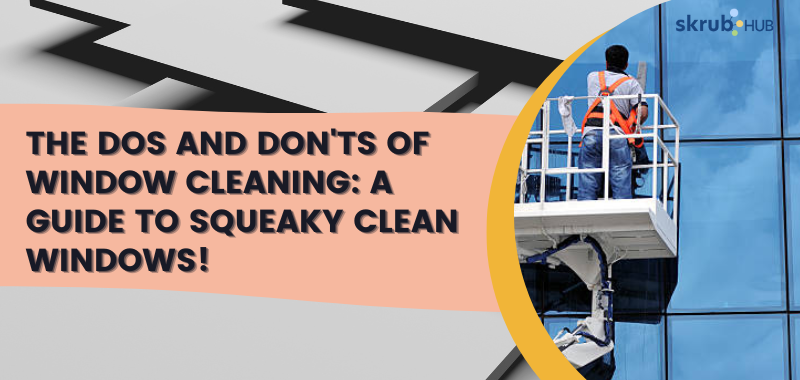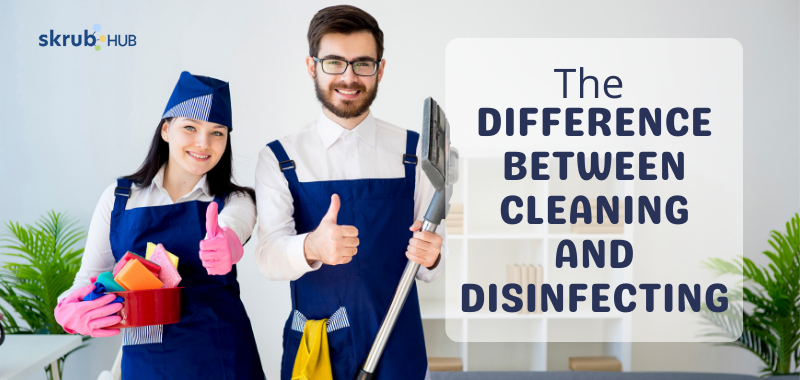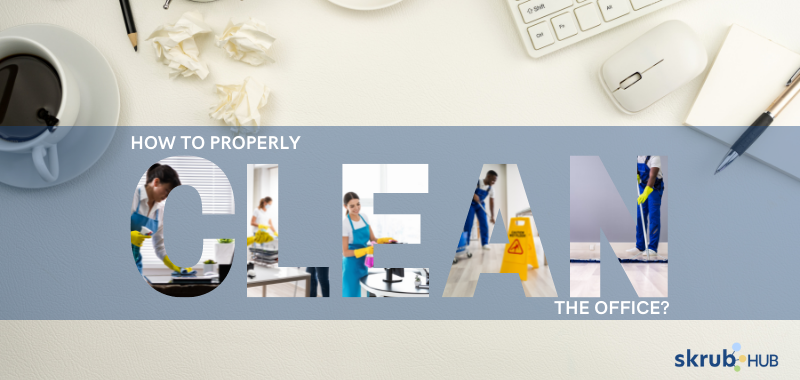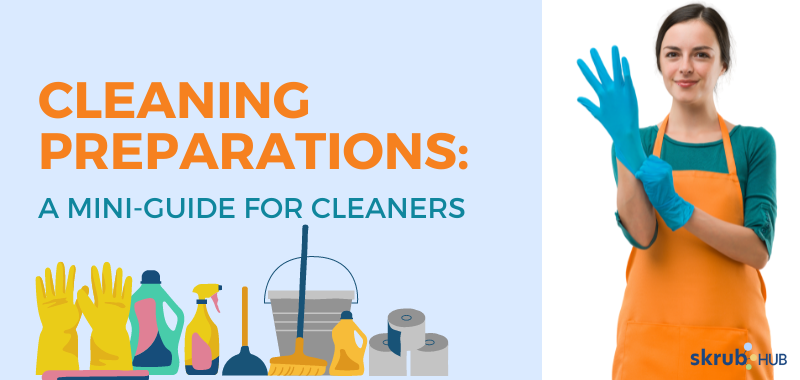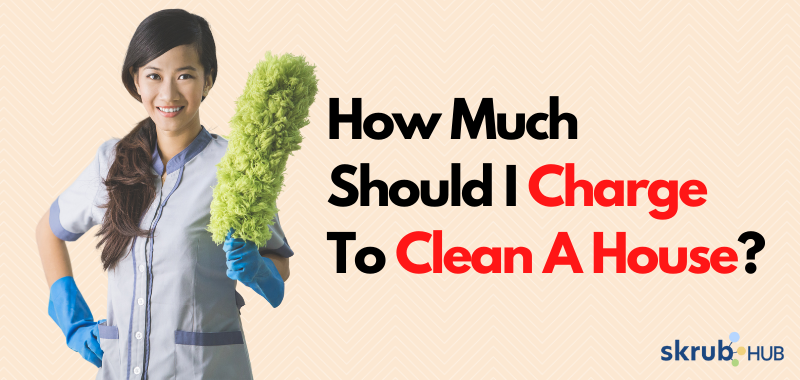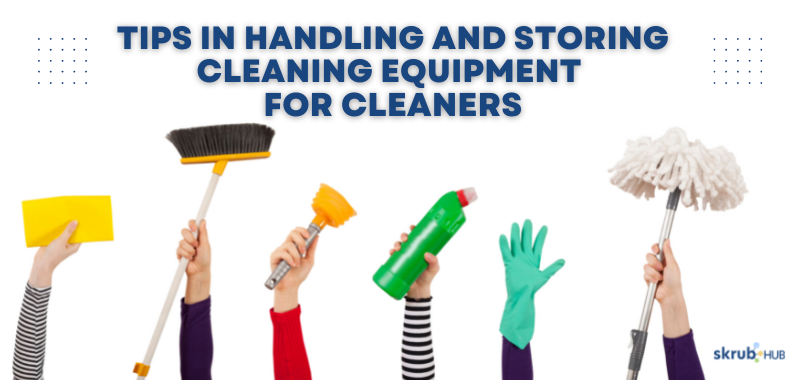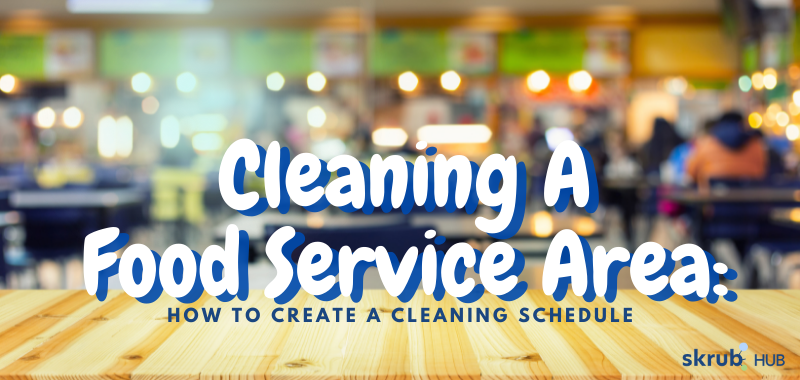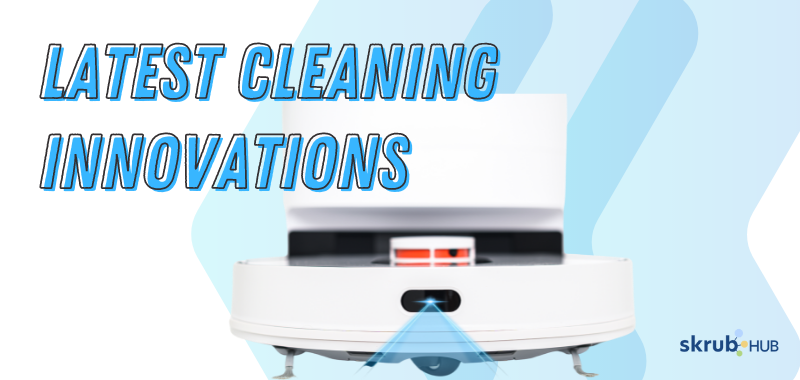
Latest Cleaning Business Innovations
Latest Cleaning Business Innovations
Innovation is always present in any business industry. Innovations are crucial to a business because they enhance business operations, provide new and improved goods and services to market, boost its efficiency, and, most importantly, boost its profitability. The cleaning service business is no exception to this.
Thanks to technological advancements, many cleaning issues in the past have been eliminated. We can’t dispute how much easier it is to do our day-to-day cleaning duties now that new tools and equipment are readily available. From cleaning chemicals and equipment to marketing strategies, much has changed compared to the past. Keeping abreast of these innovations will put you ahead of the curve in the cleaning industry.
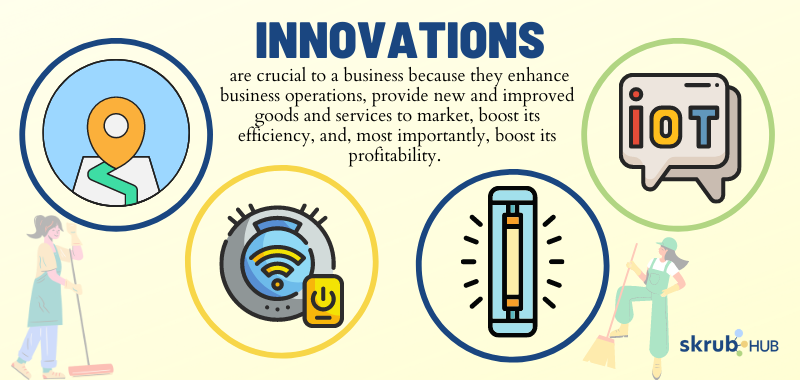
Innovations are crucial to a business because they enhance business operations
In today’s fast-paced world where convenience and time are valued more, the cleaning industry is becoming more relevant and growing fast. This article will cover the latest cleaning trends and strategies that can help expand your cleaning business.
Sustainable Cleaning Products and Practices
Over a thousand scientists joined protests around the globe during the second week of April 2022. This occurred after the release of the new Intergovernmental Panel on Climate Change (IPCC) report. The said report warned that if decisive efforts to reduce greenhouse gas emissions are not implemented by 2025, catastrophic effects of climate change will occur.
Minimizing environmental damage is becoming increasingly crucial in today’s professional cleaning sector. This does not only cover using “green” or eco-friendly products but also considers the whole manufacturing process. This includes the overall life cycle of the product, shifting to sustainable packaging and eco-labelling.

Integrating sustainability into your company plan is likely to increase consumer, employee, and investor trust
Environmental considerations in the cleaning industry have been gaining traction for the past years and are more relevant than ever. Where ‘going green’ has been an extra feature before, it should be the norm by now. Using eco-friendly commercial cleaning products and equipment can help reduce water use, air pollution, and waste generation and help save money.
Aside from using eco-friendly products and equipment, implementing sustainable practices should also be considered by your cleaning company. Integrating sustainability into your company plan is likely to increase consumer, employee, and investor trust while also helping to safeguard the environment.
Automated Cleaning Machines
While some had already adopted the use of robotic cleaners in the cleaning industry before the pandemic, COVID-19 has accelerated the demand for the deployment of this technology due to heightened health and safety concerns, growing labour costs, and restricted resources. In addition, robots have the advantage of being able to clean faster and the ability to do things more consistently. After all, it’s far easier for a machine to repeat a task 500 times without needing to rest.
Automated programmable floor scrubbers are extensively used today and include built-in cameras and sensors that work with an intuitive user interface to safely navigate cleaning areas, recognize and avoid people and objects, and learn new routes. Their sensors capture data in real-time and can even notify management when cleaning duties are completed, tanks need to be refilled, or necessary maintenance. On top of floor and carpet cleaning, robots can also do disinfection.
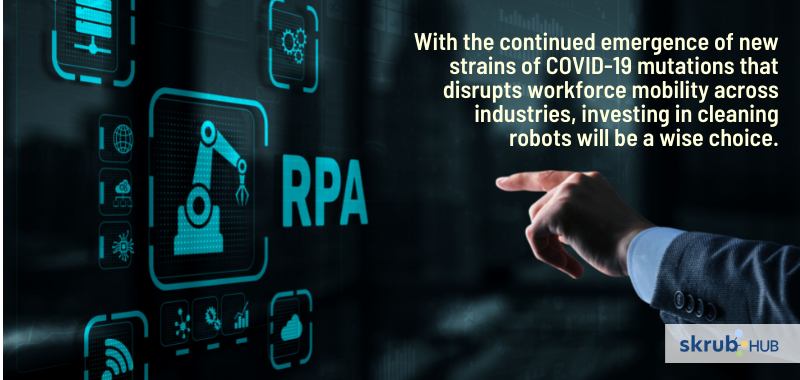
With the continued emergence of new strains of COVID-19 mutations that disrupts workforce mobility across industries, investing in cleaning robots will be a wise choice
Some may argue that cleaning robots are taking away work from people. But they are actually beneficial to cleaning staff too! Automated cleaning machines’ primary purpose is to make cleaning staff’s jobs easier by doing hard and repetitive work with workers’ guidance.
Perhaps the top selling point of automation, especially during this pandemic, is mitigating the exposure of the staff to potentially hazardous situations without compromising the operations of a cleaning company. With the continued emergence of new strains of COVID-19 mutations that disrupts workforce mobility across industries, investing in cleaning robots will be a wise choice.
Self-cleaning Antimicrobial Protectants
Antimicrobial coating products protect against pathogens when wiped or sprayed unto surfaces. They are marketed as “passive self-cleaning” solutions. When applied to coat a surface, the product forms a barrier against pathogen growth following the anti-biofouling approach and the bacterial approach. With the anti-biofouling process, the solution covers a surface and decreases the chances of bacteria sticking to the surface. The bacterial approach works by the presence of spiked protein nanostructures that breach the microbe’s cell wall, rendering it dead.
Self-cleaning, antimicrobial surface solutions are versatile; they can be applied to varied surfaces, including flooring, walls, doorknobs, electronics, and other commonly contaminated surfaces. This product, however, is not to be used as a stand-alone cleaning answer. But it can aid in the reduction of pathogen transmission and replication between cleanings. Additionally, not all long-lasting antimicrobial surface protectants contain disinfectants proven to be effective against the SARS-CoV-2 virus, which causes COVID-19.
This product line is still in its development phase, but its market growth has been projected to increase in the next four years. Safe to say, self-cleaning and antimicrobial surface protectants are products you should definitely watch.
Ultraviolet Cleaning Technology
The use of ultraviolet (UV) cleaning technology is another step in the continued effort to disinfect homes and office spaces from disease-causing microorganisms. Using UV light is not an entirely novel technique. This technology has already been used as early as 50 years ago to sterilize drinking and wastewaters, air, medicinal products and spaces. But like other disinfection technologies, the pandemic has brought an increased demand for it.
UVC light refers to ultraviolet radiation with wavelengths of 200-280 nanometers that have been proven to be most effective in inactivating a wide range of bacteria and viruses. UVC radiation cleans pathogens, both bacteria and viruses, by destroying their DNA and RNA and leaving them unable to replicate.
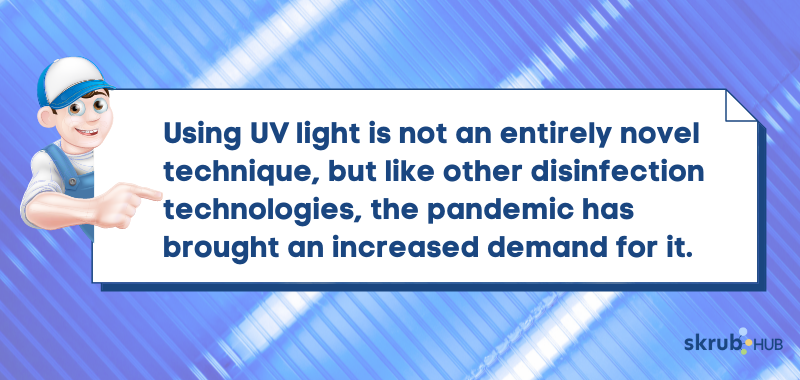
Using UV light is not an entirely novel technique. This technology has already been used as early as 50 years ago to sterilize drinking and wastewaters, air, medicinal products and spaces
Although there is limited data to support claims against the effectiveness of UVC against SARS-CoV-2, the virus responsible for COVID-19, according to the International Ultraviolet Association IUVA, all bacteria and viruses studied to date (hundreds throughout the years, including different coronaviruses) react to UV disinfection. When used in combination with other cleaning methods and appropriately administered by well-trained cleaning personnel, UVC disinfection is efficient in killing germs.
the Internet of Things (IoT)
We no longer think much about it, but the internet has dramatically made our lives easier. This is because devices are easily linked with each other. Thanks to the internet, a device can be controlled remotely through another device. For example, when applied in the cleaning industry, the Internet of Things (IoT) can track and transfer real-time data during cleaning operations, even across long distances.
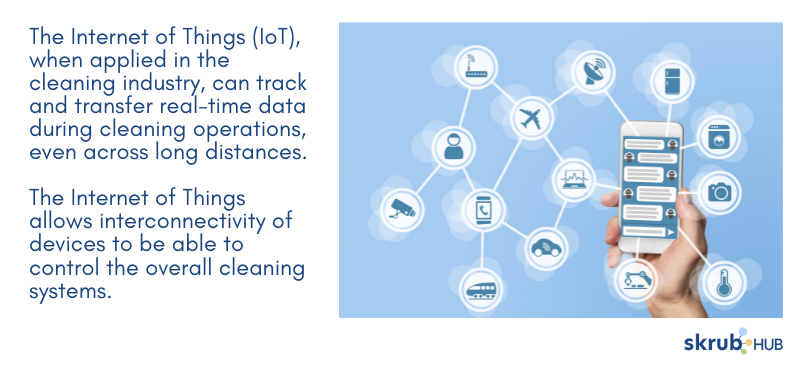
When applied in the cleaning industry, the Internet of Things (IoT) can track and transfer real-time data during cleaning operations, even across long distances
The supply level can easily be monitored through IoT, and the operator can be immediately refilled. Additionally, it is utilized to link together and instruct cleaning robots and collect data on operation issues. The Internet of Things allows interconnectivity of devices to be able to control the overall cleaning systems.
Data Management Tools and Services
With the advancement of technology, data can now also be quickly recorded and analyzed through available tools and software. This includes tools for remotely managing cleaning teams and scheduling, data collection, and transmission.
For example, time monitoring in combination with GPS tracking can significantly increase the productivity and efficiency of your cleaning company. You can readily see when and where your team worked each day and the projects on which they focused their efforts.
Even better are time tracking applications that include geofencing. These applications will begin monitoring the time any of the responsible cleaning team enters the set job location. Additional features of these apps have a scheduling tool that can automatically arrange one-time or regular shifts and receive notifications when a crew is absent, arrives late, or departs early.
Lead Generation and Customer Management Tools
Data gathered from customer patterns is a good way for a cleaning company to improve its operation and give relevant feedback to them. Lead generation tools offer features that’ll assist you in managing customer relations. For example, locating emails, planning tasks, monitoring company performance, and assessing which leads are worth pursuing and which are not will just be a few clicks away. With this, designing effective marketing programs will be a breeze for your company.
If your company attracts and brings in more customers, doing customer tracking manually would be difficult and time-consuming. This is where customer management tools (CMT) or customer relationship management tools (CRM) come into the picture. CMT helps in recording and compiling all customer data in a single directory. They will let you communicate more effectively with customers and potential clients and assist in providing necessary services to consumers. Using them will prevent instances of customers’ queries being missed, and prior messages from them can readily be accessed. Additionally, these technologies may be used in conjunction with other automation tools like chatbots and ticket forwarding.
Conclusion
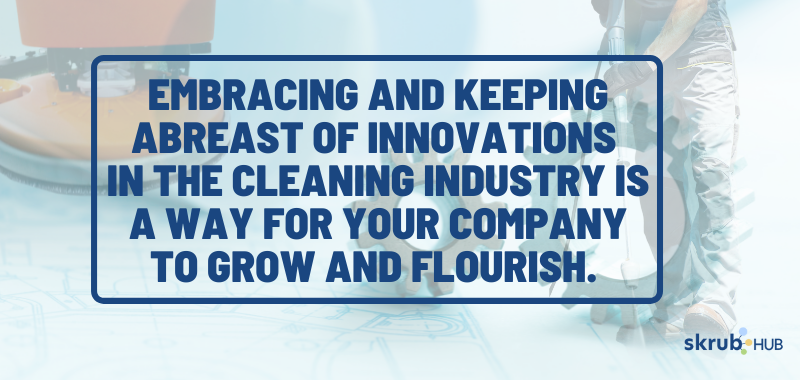
Embracing and keeping abreast of innovations in the cleaning industry is a way for your company to grow and flourish
Embracing and keeping abreast of innovations in the cleaning industry is a way for your company to grow and flourish. Many of the mentioned innovations in this article are worth checking due to their capacity to simplify, automate, and save time and money on your cleaning operations. While some of these breakthroughs have been present for some time, they continue to improve and pave the way for new technology. They’re all worth a shot to see how they affect your cleaning business at the end of the day.
Related Post
The dos and don’ts of window cleaning: A guide to squeaky clean windows! A window is where you look out...
The difference between cleaning and disinfecting As cleaners, you always have to ensure you leave the area clean. Usually, you...
Cleaning processes vary depending on your preference. However, there are recommended processes that can be beneficial for you to do your...
How to remove pet soils from the carpet? Your home is where you find comfort and solace every day and whenever...
How to reach high fixtures and drapery for cleaning? – A quick solution to high-placed problems! A tidy house is...
How Color Coding is Essential in Cleaning People may not understand the significance of colours in the world. They might...
How to Eradicate Odor when Cleaning Scamming is also present in the cleaning world. Sometimes, you may feel like the...
How To Empty and Remove Waste in Offices While cleaning is an essential practice to follow, waste disposal is as...
How To Clean Bathrooms in Offices The main purpose of cleaning is to provide a safe and hygienic space for...
The Significance of Cleaning with Microfiber Products and Detergents Cleaning is of utmost essential, especially in offices where numerous people are...
How to Properly Clean the Office With the proper preparations, you are now equipped to face the cleaning properly. You will...
How to Clean Effectively In A Short Amount of Time? Cleaning varies on personal preference. Some may think that cleaning is...
Cleaning Preparations: A Mini-Guide for Cleaners It is always essential for you to prepare when cleaning an office building. By being...
How Much Should I Charge To Clean A House? Planning on the pricing of package rates and hourly rates for cleaning...
Tips in Handling and Storing Cleaning Equipment and Disposing Chemical for Cleaners Doing aftercare takes a lot of work to...
Ultimate Way to Assess Cleaning Requirements for Food Handling Area Having the food handling area clean is very significant in...
Cleaning a Food Service Area: How to Create a Cleaning Schedule Cleaning is an important aspect of maintaining a food service...
How to Properly Clean a Food Service Area Cleaners in a food service area are often seen cleaning the premises constantly....


